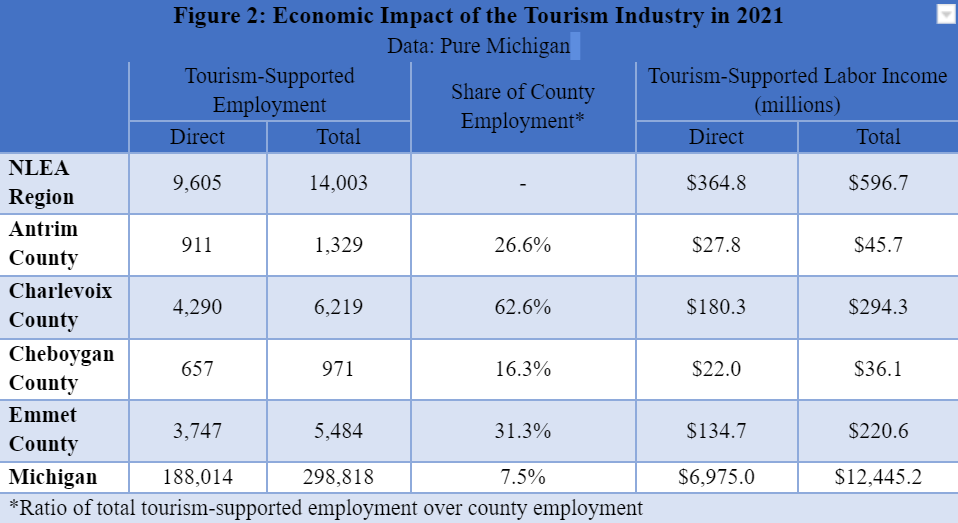Examining the economic impact of tourism through PureMichigan data and seasonal population estimates.
By Sam Bailey, Strategic Initiatives Manager
The short answer, a lot. Now that it is June, seasonal residents and visitors are arriving in Northern Lower Michigan, filling local restaurants and hotels, shopping in stores, attending festivals and community events. In policy discussions, Northern Lower Michigan is often characterized as having a tourism or resort economy, but what is the actual impact of the industry?
There are many ways to examine the impact of an industry: jobs, consumer spending, wages paid, and other metrics. Fortunately, Pure Michigan releases annual reports that review the economic impact of tourism at the county level. In total, visitor spending in the NLEA service area grew from $856.6 million in 2016 to $1.09 billion in 2021. Figure 1 shows estimates for visitor spending changed in Antrim, Charlevoix, Cheboygan, and Emmet Counties from 2016 to 2021.
The figure reveals steady growth in tourism spending from 2016 to 2019 before spending decreased due to the pandemic. By 2021 however, each county had exceeded its pre-pandemic visitor spending. With spending growth rates of 29.1% and 32.8% respectively from 2020 to 2021, Cheboygan and Emmet Counties outpaced the 27.6% growth rate of the state’s tourism industry. The figure also reveals that much of visitor spending is concentrated in Emmet and Charlevoix Counties which is to be expected given the larger volume of visitors that they receive. While total spending is a solid metric, it is important to consider how visitors are spending their money.

The billion plus dollars of the local tourism sector flows through a variety of establishments. According to Pure Michigan, visitors to Antrim, Charlevoix, Cheboygan, and Emmet Counties in 2021 spent their $1.09 billion as follows: 34.7% on lodging, 20.9% on food and beverage, 12.0% on retail, 16.6% on recreation, and 15.7% on transportation. A breakdown of spending by county can be found on the Pure Michigan website. All that spending generated $124.4 million in tax revenues, a small portion of the over $2.95 billion that the tourism industry generates statewide. Visitor spending on lodging further supports the local tourism sector because a portion of that revenue is directed to local visitors bureaus, like the Petoskey Area and Cheboygan Area Visitors Bureaus. These organizations are responsible for advertising the region, attracting new visitors and highlighting local attractions. While visitor spending gives an idea of the size of an industry, it is important to understand how those dollars circulate through local economy.
Figure 2 provides estimates of the jobs and wages supported by the tourism in the region. The total columns are calculated by combining direct and indirect impacts. Direct jobs are the jobs in the tourism sector provided by hotels, campgrounds, restaurants, shops, marinas, and other businesses. By extension, direct income is the wages paid by these jobs. Indirect jobs and wages are created by the spending of individuals in the tourism sector. When a hotel manager spends money at the grocery store, the local auto mechanic, and the pharmacy, they support the jobs and wages of those businesses. The children of tourism employees require childcare and schooling, this creates more jobs and wages.

These estimates show the significant role of the tourism sector to the local economy; it employs a large share of people and represents a traded cluster. Economic developers talk in terms of local and traded clusters. Local clusters consist of industries that serve the local market and move money within a community; healthcare and education are two examples. In contrast, traded clusters are industries that serve markets beyond the local region and bring dollars into a community. As a traded cluster, the local tourism sector is competing with other vacation destinations and is bringing dollars into the local community. Those dollars are then recirculated through wages, supply chains, and employees. The strength of Northern Lower Michigan’s tourism industry should be a point of pride, but it is also a cause for concern.
The tourism sector is integral to the local economy, but it faces the challenge of seasons. The seasonal nature of the industry contributes to annual fluctuations in local unemployment rates, a concerning phenomenon. Each year, unemployment rates rise from July lows to wintertime highs: Antrim’s increases three to five percent, Charlevoix’s increases three to four percent, Cheboygan’s increases ten to fourteen percent, and Emmet’s increases three to four percent. The annual layoff cycle poses a significant barrier to individuals and families trying to improve their well-being. This troubling reality reveals the need to provide more stable, year-round employment by growing other industries, like manufacturing and professional services, and expanding the shoulder seasons of the tourism sector. These two strategies are an opportunity to reduce seasonal unemployment and improve the socioeconomic status of residents.
The NLEA provides project-based support to businesses in a variety of sectors as they look to expand in our area. Contact Buck Love buck@northernlakes.net to learn more about the variety of local, state, and federal tools available to assist your business. To address the challenges faced by all sectors, the NLEA has added talent attraction, retention, and engagement as an area of focus. The 2023 Northern Lakes Economic Symposium and Showcase brought experts from around the state to the area to discuss the issue. The 2023 NLEA/DTE Energy Foundation interns will soon launch a social media brand with the goal highlighting why Northern Lower Michigan is the best place to live and work, not just visit. To learn more about these initiatives and the other services the NLEA provides, please contact us at info@northernlakes.net.







